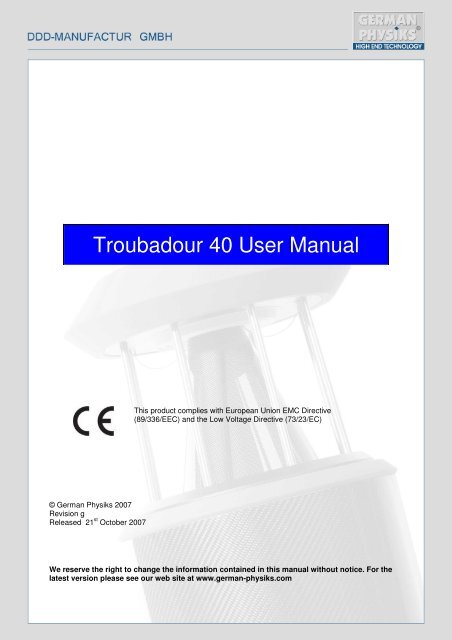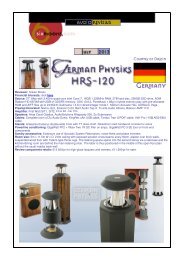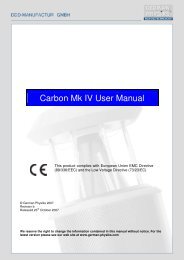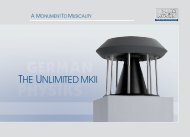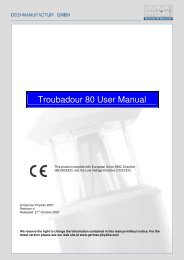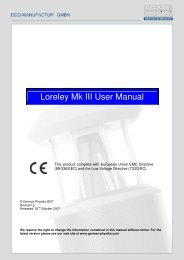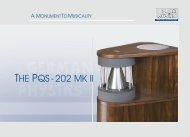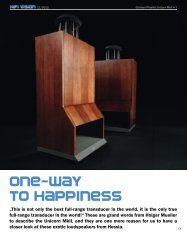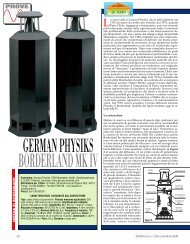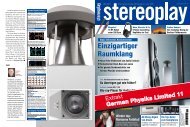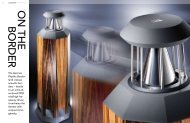Troubadour 40 User Manual - German Physiks
Troubadour 40 User Manual - German Physiks
Troubadour 40 User Manual - German Physiks
You also want an ePaper? Increase the reach of your titles
YUMPU automatically turns print PDFs into web optimized ePapers that Google loves.
<strong>Troubadour</strong> <strong>40</strong> <strong>User</strong> <strong>Manual</strong><br />
This product complies with European Union EMC Directive<br />
(89/336/EEC) and the Low Voltage Directive (73/23/EC)<br />
© <strong>German</strong> <strong>Physiks</strong> 2007<br />
Revision g<br />
Released 21 st October 2007<br />
We reserve the right to change the information contained in this manual without notice. For the<br />
latest version please see our web site at www.german-physiks.com
TABLE OF CONTENTS<br />
1. INTRODUCTION..................................................................................................................................3<br />
2. UNPACKING YOUR LOUDSPEAKERS ..............................................................................................3<br />
3. PRINCIPLE FEATURES OF THE TROUBADOUR <strong>40</strong> ........................................................................4<br />
4. LOUDSPEAKER PLACEMENT AND SET-UP ....................................................................................5<br />
Listening Room Layout ....................................................................................................................5<br />
Loudspeaker Placement ..................................................................................................................5<br />
Stands:........................................................................................................................................5<br />
Distance from rear wall: ..............................................................................................................5<br />
Distance from side wall:..............................................................................................................6<br />
5. CONNECTING YOUR LOUDSPEAKERS ...........................................................................................7<br />
Titanium DDD Version .....................................................................................................................7<br />
High Frequency Level Control ....................................................................................................7<br />
Low Frequency Roll-Off Control .................................................................................................7<br />
Carbon Fibre DDD Version ..............................................................................................................8<br />
High Frequency Level Control ....................................................................................................8<br />
Low Frequency Roll-Off Control .................................................................................................8<br />
Input Terminal Connections .............................................................................................................8<br />
6. REMOVING THE DDD SHIPPING COVERS ......................................................................................9<br />
7. LOUDSPEAKER BREAK IN.................................................................................................................9<br />
8. CARE OF YOUR LOUDSPEAKERS....................................................................................................9<br />
9. WARRANTY .........................................................................................................................................10<br />
10. SERVICE AND SUPPORT..................................................................................................................10<br />
11. HOW TO CONTACT US .....................................................................................................................11<br />
12. TROUBADOUR <strong>40</strong> SPECIFICATIONS...............................................................................................12<br />
13. WARRANTY REGISTRATION............................................................................................................13<br />
2
1. INTRODUCTION<br />
Thank you for selecting the <strong>German</strong> <strong>Physiks</strong> <strong>Troubadour</strong> <strong>40</strong> loudspeakers for your audio system. The<br />
design uses a single DDD driver and may be operated either full range where a compact high quality<br />
loudspeaker is required for a small room, or in conjunction with a sub-woofer where higher sound levels<br />
are required. The <strong>Troubadour</strong> <strong>40</strong> is entirely handmade and is built and tested by highly skilled<br />
technicians at our factory in <strong>German</strong>y.<br />
Every step in the design and manufacture of this product has been dedicated to producing a loudspeaker<br />
that will provide a lifetime of musical enjoyment.<br />
We strongly recommend that you read this manual before you attempt to use the loudspeakers.<br />
2. UNPACKING YOUR LOUDSPEAKERS<br />
NOTE:<br />
When lifting the loudspeakers out of the packing, hold them<br />
around the base. Do not lift them by the DDD driver support<br />
pillars (see figure 3) as this may damage the driver.<br />
The DDD drivers may be protected with clear film or<br />
cardboard covers. We recommend that these be left in place<br />
until the loudspeakers have been placed in their final location<br />
so as to guard against accidental damage during handling.<br />
The <strong>Troubadour</strong> <strong>40</strong> comprises two loudspeaker modules and two crossover modules. The two<br />
loudspeakers are packed in one carton and the two crossovers and interconnecting cables are packed in<br />
a second carton. Before opening the cartons, please inspect them for damage. If you see any damage<br />
to the cartons, please contact the supplying audio dealer immediately and provide them with a full<br />
description of the damage. Do not attempt to unpack the loudspeakers until you have spoken with the<br />
dealer and have been advised how to proceed.<br />
Please retain all of the packing as you will need this should it be necessary in the future to ship the<br />
loudspeakers. Should you need to return the loudspeakers to the factory, you must use the original<br />
packing. The use of any other packing may result in the loudspeakers sustaining damage in transit.<br />
Such damage is not covered by the warranty. Should you require replacement packing, please contact<br />
your <strong>German</strong> <strong>Physiks</strong> dealer, the national distributor or the factory directly.<br />
Use Figure 1 to identify the major components and confirm that the cartons contain the following items:<br />
Item Quantity Description<br />
1 2 <strong>Troubadour</strong> <strong>40</strong> loudspeakers<br />
2 2 <strong>Troubadour</strong> <strong>40</strong> crossovers<br />
3 2 Crossover cable<br />
4 1 <strong>User</strong> manual<br />
If any items are missing, or if any item shows signs of damage, please contact the supplying audio<br />
dealer immediately.<br />
3
<strong>Troubadour</strong> <strong>40</strong> Crossover Crossover cable<br />
Figure 1. <strong>Troubadour</strong> <strong>40</strong> Major Components<br />
There are two versions of the <strong>Troubadour</strong> <strong>40</strong>. One is fitted with a titanium DDD driver and the other is<br />
fitted with a carbon fibre DDD driver. Each version has its own specific design of crossover. Please use<br />
figure 2 below to confirm that the correct version of the crossover has been supplied.<br />
For titanium DDD driver<br />
For carbon fibre DDD driver<br />
Figure 2. <strong>Troubadour</strong> <strong>40</strong> Crossovers<br />
3. PRINCIPLE FEATURES OF THE TROUBADOUR <strong>40</strong><br />
DDD support<br />
pillars<br />
DDD driver<br />
Feet<br />
Input terminals<br />
Serial number<br />
label<br />
Figure 3. Principle Features of the <strong>Troubadour</strong> <strong>40</strong><br />
4
4. LOUDSPEAKER PLACEMENT AND SET-UP<br />
NOTE:<br />
DO NOT place the loudspeakers close to cathode ray type<br />
monitors or projectors, as the very powerful magnets used<br />
in the drivers may affect the picture. We recommend a<br />
minimum separation of 2m.<br />
The <strong>Troubadour</strong> <strong>40</strong> is symmetrical, so either speaker may<br />
be use on the left or right side or the room.<br />
Listening Room Layout<br />
The following points will help you optimise your listening room layout.<br />
1. The left and right sides of the room should be symmetrical. If the room is asymmetrical, this will<br />
degrade the quality of the stereo image. This is because most of the sound energy that you hear is<br />
reflected before it reaches your ears.<br />
2. Place the speakers symmetrically in the room, i.e. the same distance from the centre line of the room<br />
and the same distance from the rear wall.<br />
3. Avoid placing the loudspeakers similar distances from the side and rear walls, as this may lead to an<br />
uneven bass response<br />
4. Avoid having any hard surfaces between your listening position and the loudspeakers. This will<br />
generate additional reflections that may degrade the stereo image. For this reason, where ever possible<br />
equipment should be located at the side of the room. If you have a hardwood floor, it may be<br />
advantageous to place a carpet on the floor covering the area between the loudspeakers and the<br />
listening position, as this will reduce unwanted early reflections.<br />
5. Avoid having the listening position closer than 1.2m from the rear wall as early reflections from this<br />
wall will degrade the stereo image.<br />
Loudspeaker Placement<br />
Stands: The <strong>Troubadour</strong> <strong>40</strong> may be placed on stands or on a shelf. In either case please follow the<br />
recommendations below regarding distances from the rear and side walls<br />
If stands are to be used, you should aim to have the centre of the DDD driver approximately on the same<br />
level as your ears when you are seated in the listening position. In most cases this gives a suggested<br />
range of heights for stands of between 70 and 80 cm (27.6” to 31.5”). The <strong>Troubadour</strong> <strong>40</strong> has 4 feet on<br />
its base plate. These are located on a 10.5 cm radius from the centre of the base and are positioned at<br />
the 3, 6, 9 and 12 0’ clock positions. To allow a safe margin for the feet and prevent them slipping over<br />
the edge of the top of the stand, the stand top plate should be no smaller than 23 cm wide by 23 cm<br />
deep (9” by 9”).<br />
Distance from rear wall: We recommend that you start with the loudspeaker positioned 1.5m from the<br />
rear wall. As you move the loudspeaker closer to the wall the level of the bass response will be<br />
increased. The converse will be true as you move the speaker away from the rear wall. The <strong>Troubadour</strong><br />
<strong>40</strong> should not be placed closer that 1m from the rear wall. If the speaker is too close to the rear wall, not<br />
only will the bass response be excessive, but the stereo image will be degraded due to an increase in<br />
early reflections. Aim to find a position that provides an even bass response so that all the bass notes in<br />
the music are reproduced at an equal level. Be sure to choose a recording that itself has an even bass<br />
response.<br />
5
Distance from side wall: We recommend that the distance between the centres of the loudspeakers<br />
be 2/3 of the distance of the loudspeakers from the listening point. Moving the speakers further apart will<br />
degrade the stereo image.<br />
Avoid placing the loudspeakers closer than 1m from the side walls, as the early reflections will degrade<br />
the stereo image.<br />
Positioning the loudspeakers too close to the side walls will also lead to an uneven bass response. Aim<br />
to find the position that provides the best defined and most realistic stereo image when you are seated at<br />
the listening position.<br />
Figure 4 gives a general guide to loudspeaker positioning and the location of the listening position. Note<br />
how the recommended listening position varies with the separation between the loudspeakers. Because<br />
the <strong>Troubadour</strong> <strong>40</strong> is omni directional, there is no need to adjust the toe-in angle. The loudspeakers<br />
should always be set with the front of the speakers facing down the room. The <strong>German</strong> <strong>Physiks</strong> logo on<br />
top of the loudspeaker indicates the front of the unit.<br />
Minimum:<br />
1 metre/3.3 feet<br />
Minimum:<br />
1 metre/3.3 feet<br />
Distance = “d”<br />
Minimum:<br />
1 metre/3.3 feet<br />
Minimum:<br />
1 metre/3.3 feet<br />
Left speaker<br />
Right speaker<br />
Listening<br />
Position<br />
Figure 4. Listening Room Arrangement<br />
6
5. CONNECTING YOUR LOUDSPEAKERS<br />
NOTE:<br />
The <strong>Troubadour</strong> <strong>40</strong> must be used with the crossover<br />
supplied. Do not attempt to drive it directly from your<br />
amplifier as this may result in damage the DDD driver.<br />
There are two versions of the <strong>Troubadour</strong> <strong>40</strong> and the method of connection varies slightly. Both versions<br />
have a high frequency level adjustment control to allow the user to compensate for variations in the<br />
listening room high frequency absorption characteristic. They also both have a low frequency roll-off<br />
control. This is used when the loudspeaker is used in conjunction with a sub woofer and allows the<br />
loudspeaker’s low frequency limit to be set to match the upper limit of the sub-woofer.<br />
The input terminals and both controls are located on the external crossover. A detailed description of the<br />
two versions of the crossover is given below.<br />
Titanium DDD Version<br />
High Frequency<br />
Level Control<br />
Input Terminals<br />
Low Frequency<br />
Roll-Off Control<br />
Figure 5. Input Terminals and Crossover Adjustments for Titanium DDD <strong>Troubadour</strong> <strong>40</strong><br />
High Frequency Level Control<br />
4 settings are provided: -2dB, Flat, +2dB and +4dB and the centre frequency is 8,000Hz. To adjust the<br />
control, pull the jumper out and then push it back into the appropriate pair of sockets.<br />
Low Frequency Roll-Off Control<br />
This adjusts the low frequency roll-off. When using the <strong>Troubadour</strong> <strong>40</strong> in full range mode fit both<br />
jumpers. When using the loudspeaker in conjunction with a sub-woofer, fit the jumper(s) that give a low<br />
frequency roll-off that is the closest match to the upper frequency limit of the sub-woofer being used.<br />
The jumper settings are shown below:<br />
Jumper Setting<br />
Red and black socket jumpers fitted<br />
Red socket jumper only fitted<br />
Black socket jumper only fitted<br />
No jumpers fitted<br />
Roll Off<br />
2<strong>40</strong>Hz<br />
260Hz<br />
300Hz<br />
320Hz<br />
7
Carbon Fibre DDD Version<br />
High Frequency<br />
Level Control<br />
Low Frequency<br />
Roll-Off Control<br />
Input Terminals<br />
Figure 6. Input Terminals and Crossover Adjustments for Carbon Fibre DDD <strong>Troubadour</strong> <strong>40</strong><br />
High Frequency Level Control<br />
4 settings are provided: -2dB, Flat, +2dB and +4dB and the centre frequency is 8,000Hz. To adjust the<br />
control, pull the jumper out and then push it back into the appropriate pair of sockets.<br />
Low Frequency Roll-Off Control<br />
This adjusts the low frequency roll-off. When using the <strong>Troubadour</strong> <strong>40</strong> in full range mode fit both<br />
jumpers in the red sockets. When using the loudspeaker in conjunction with a sub-woofer, fit both<br />
jumpers in the black sockets. The roll-off frequencies are shown below:<br />
Jumper Setting<br />
Both red socket jumpers fitted<br />
Both black socket jumpers fitted<br />
Roll Off<br />
80Hz<br />
270Hz<br />
Input Terminal Connections<br />
NOTE:<br />
The loudspeaker input terminals should be tightened as<br />
firmly as possible by hand. Do not use pliers or any other<br />
tools as this may damage the terminals.<br />
Use the cable supplied to connect the input sockets on the base of the <strong>Troubadour</strong> <strong>40</strong> (figure 3) to the<br />
output sockets on the side of the external crossover. Ensure that the two red sockets are connected<br />
together and that the two black sockets are connected together. Connect the amplifier to the input<br />
terminals on the top of the external crossover. Do not connect the amplifier directly to the <strong>Troubadour</strong> <strong>40</strong><br />
as this may result in damage to the DDD driver which will not be covered under the warranty.<br />
We recommend that you use loudspeaker cables terminated with high quality spade lugs, as these<br />
provide the best electrical connection. The lugs should be either soldered or crimped to the cable – the<br />
latter is preferred. We do not recommend the use of bare wire to connect to the loudspeaker terminals.<br />
This produces an inferior connection that will degrade as the bare conductors become tarnished.<br />
8
An amplifier capable of delivering at least <strong>40</strong>W rms into 4 ohms per channel should be used for each<br />
loudspeaker. Do not switch the amplifier on until the DDD covers have been removed as shown in<br />
section 6.<br />
6. REMOVING THE DDD SHIPPING COVERS<br />
If your <strong>Troubadour</strong> <strong>40</strong>s are fitted with titanium DDD drivers these will be covered with either a layer of<br />
clear film or cardboard to protect them whilst in transit. This should now be removed. The film should be<br />
peeled off by hand. Do not use a knife.<br />
To remove the cardboard protector, slit the adhesive tape securing it by sliding a short bladed knife<br />
between the two layers of cardboard whilst holding the knife as shown in figure 7. Do not cut in the way<br />
shown in figure 8, as there is a danger that you will cut the DDD driver diaphragm.<br />
Figure 7. The Correct Way to<br />
Remove the DDD Driver Cover<br />
Figure 8. The Wrong Way to<br />
Remove the DDD Driver Cover<br />
7. LOUDSPEAKER BREAK IN<br />
Like all audiophile equipment, <strong>German</strong> <strong>Physiks</strong> loudspeakers require a break in period from new before<br />
they reach their optimum level of performance. The music used for the break in should be dynamic in<br />
order to properly exercise all the components of the loudspeaker.<br />
For the first 10 hours play the loudspeaker at low level only. This is a level where you would easily be<br />
able to carry out a conversation without needing to raise your voice.<br />
After this, the speaker may be played at normal listening levels. The break in process will be complete<br />
after 200 to 300 hours.<br />
8. CARE OF YOUR LOUDSPEAKERS<br />
NOTE:<br />
NEVER attempt to open the cabinets. There are no user<br />
serviceable parts inside the loudspeakers or crossovers.<br />
NEVER touch the diaphragm on the DDD driver, or allow<br />
any object to come into contact with the diaphragm.<br />
9
NOTE:<br />
NEVER attempt to clean the dust off the diaphragm. Dust<br />
has no affect on its performance and may be safely<br />
ignored.<br />
NEVER attempt to clean the loudspeakers or crossovers<br />
with any abrasive materials or any cleaners containing<br />
ammonia, alcohol or other solvents, as these may damage<br />
the finish.<br />
The only maintenance the speakers will require is periodic dusting to remove dust and any finger prints<br />
from the cabinets.<br />
9. WARRANTY<br />
Your <strong>German</strong> <strong>Physiks</strong> loudspeakers are warranted to be free from defects if used under normal<br />
conditions for a period of 5 years from the date of purchase, provided that the customer registers their<br />
purchase by completing and returning the registration form in this manual within 7 days of purchase.<br />
They must also return a copy of the receipt issued at the time of purchase. If this is not done the<br />
warranty period will be 5 years from the date of shipment from the factory. This warranty is transferable<br />
to subsequent owners, who must register their purchase with us.<br />
Modifications or repairs performed by the factory, or by an authorised repair agent, shall be guaranteed<br />
for the remaining period of the warranty, or for 1 year, which ever is greater.<br />
Any unauthorised modifications or repairs will invalidate the warranty. The warranty will also be<br />
invalidated if <strong>German</strong> <strong>Physiks</strong> determines that the unit has been subject to misuse including, but not<br />
limited to, burnt out voice coils and dents or scratches on driver diaphragms or cabinets.<br />
There is no other express warranty on <strong>German</strong> <strong>Physiks</strong> products. This warranty shall not extend beyond<br />
the stated warranty period. No responsibility is assumed for incidental or consequential damage.<br />
10. SERVICE AND SUPPORT<br />
In the first instance please contact your local <strong>German</strong> <strong>Physiks</strong> dealer or distributor. They will diagnose<br />
the fault and liaise with <strong>German</strong> <strong>Physiks</strong> to decide the best way to affect a repair. If they unable to assist<br />
you, please contact <strong>German</strong> <strong>Physiks</strong> by phone on + 49 61 09 50 29 823, by fax on + 49 61 09 50 29<br />
826, or by email at service@german-physiks.com. Please take into account time differences between<br />
<strong>German</strong>y and where you are calling from should you need to phone us. Email is our preferred method of<br />
initial contact. Please supply the model name and serial numbers of your loudspeakers and as much<br />
detail of your problem as possible.<br />
In the vast majority of cases, the repair will be dealt with by sending spare parts from the factory. In the<br />
unlikely even that it becomes necessary to return your loudspeakers or any part of them to the factory,<br />
you will be given a Return Authorization (RA) number. This number must be clearly marked on the<br />
outside of the packing. Returns made without a RA number will not be accepted. Any returned items<br />
must be shipped in the original packing. <strong>German</strong> <strong>Physiks</strong> will not be responsible for any damage that<br />
occurs as a result of the use of non-standard packing. Returns received in non-standard packing will be<br />
replaced with new packing at the owner's expense. If you need new packing, please contact your<br />
<strong>German</strong> <strong>Physiks</strong> dealer or the factory.<br />
For items returned to the factory under warranty during the first year, <strong>German</strong> <strong>Physiks</strong> will pay for the<br />
shipping charges both ways. A shipping company approved by <strong>German</strong> <strong>Physiks</strong> must be used and the<br />
items will be returned to the customer using the same carrier, or an equivalent service.<br />
10
For loudspeakers returned to the factory under warranty after the first year, the customer is responsible<br />
for paying all shipping and related charges back to the factory. A shipping company approved by<br />
<strong>German</strong> <strong>Physiks</strong> must be used. Providing this condition is met, <strong>German</strong> <strong>Physiks</strong> will pay the cost of<br />
shipping the loudspeakers back to the customer.<br />
<strong>German</strong> <strong>Physiks</strong> will not pay any shipping costs if:<br />
a. Loudspeakers or parts are returned without a RA number<br />
b. No fault is found<br />
c. If the fault is judged to be due to misuse such as, but not limited to, burnt<br />
out voice coils and dents or scratches on driver diaphragms or cabinets.<br />
Customers are responsible for all freight, duties and related shipping charges for loudspeakers returned<br />
for non-warranty repairs.<br />
11. HOW TO CONTACT US<br />
If you wish to get in touch with us please use the contact information shown below. Please note that our<br />
office hours are from 9.30 a.m. to 5.00 p.m. Monday to Thursday, excluding public holidays and that we<br />
cannot respond to enquiries outside of these hours. We recommend that where ever possible you<br />
contact us by email, as this will allow us to give your enquiry more consideration and thus provide a more<br />
detailed reply.<br />
Address DDD-Manufactur GmbH<br />
Gutenbergstraße 4<br />
D-63477 Maintal<br />
GERMANY<br />
Telephone + 49 61 09 50 29 823<br />
Fax + 49 61 09 50 29 826<br />
Email<br />
service@german-physiks.com<br />
11
12. TROUBADOUR <strong>40</strong> SPECIFICATIONS<br />
Version With DDD Titanium Driver With DDD Carbon Driver<br />
Impedance 2.8 ohms at 1,300Hz 2.8 ohms at 2,100Hz<br />
Frequency Response<br />
With crossover 2<strong>40</strong>/320Hz – 21,500Hz 80/270Hz- 24,000Hz<br />
Lower frequency limit depends on crossover settings<br />
Without crossover 120 -21,500Hz 70 – 24,000Hz<br />
Maximum input power 20W Maximum input power 50W<br />
Power Handling<br />
With crossover<br />
Nominal 90W rms 120W rms<br />
Short term 120W peak 200W peak<br />
Without crossover<br />
Nominal 20W rms 50W rms<br />
Short term 80W peak 120W peak<br />
Amplification required<br />
High frequency adjustment<br />
Minimum <strong>40</strong>W/4 ohms<br />
-2dB, flat, +2dB and 4dB centred at 8,000Hz<br />
Low frequency adjustment 2<strong>40</strong>, 260, 300 and 320Hz 80 and 270Hz<br />
Sensitivity 84.5dB for 1W at 1m 84.8dB for 1W at 1m<br />
Operating principle<br />
Input connectors<br />
Full range satellite speaker with 360° surround radiation using<br />
the DDD Bending Wave Converter.<br />
1 set of binding posts<br />
Drivers 1 x Titanium DDD driver 1 x Carbon DDD driver<br />
Dimensions<br />
Speaker<br />
Crossover<br />
Weight<br />
Speaker<br />
Crossover<br />
Warranty<br />
<strong>40</strong>0mm high x 2<strong>40</strong>mm diameter<br />
15.75" high x 9.45" diameter<br />
230mm W x 153mm H x 230mm D<br />
9.05" W x 6.00" H x 9.05" D<br />
11.0kg<br />
24.2lbs<br />
3.9kg<br />
8.6lbs<br />
5 years<br />
As part of our process of continually improving our products, we reserve the right to change specifications without notice<br />
12
13. WARRANTY REGISTRATION<br />
In order to register your purchase and obtain the full 5 year warranty, Please complete the form below<br />
within 7 days of purchase and return it by post together with a copy of the receipt of purchase to:<br />
DDD-Manufactur GmbH<br />
Gutenbergstraße 4<br />
D-63477 Maintal<br />
GERMANY<br />
Name<br />
Address<br />
Country<br />
Zip/Post Code<br />
Speaker Model <strong>German</strong> <strong>Physiks</strong> <strong>Troubadour</strong> <strong>40</strong><br />
DDD Type<br />
Titanium/Carbon<br />
Delete as necessary<br />
Serial Number<br />
See label under speaker<br />
Finish<br />
Date of Purchase<br />
Where Purchased<br />
Address<br />
Country<br />
Zip/Post Code<br />
13


